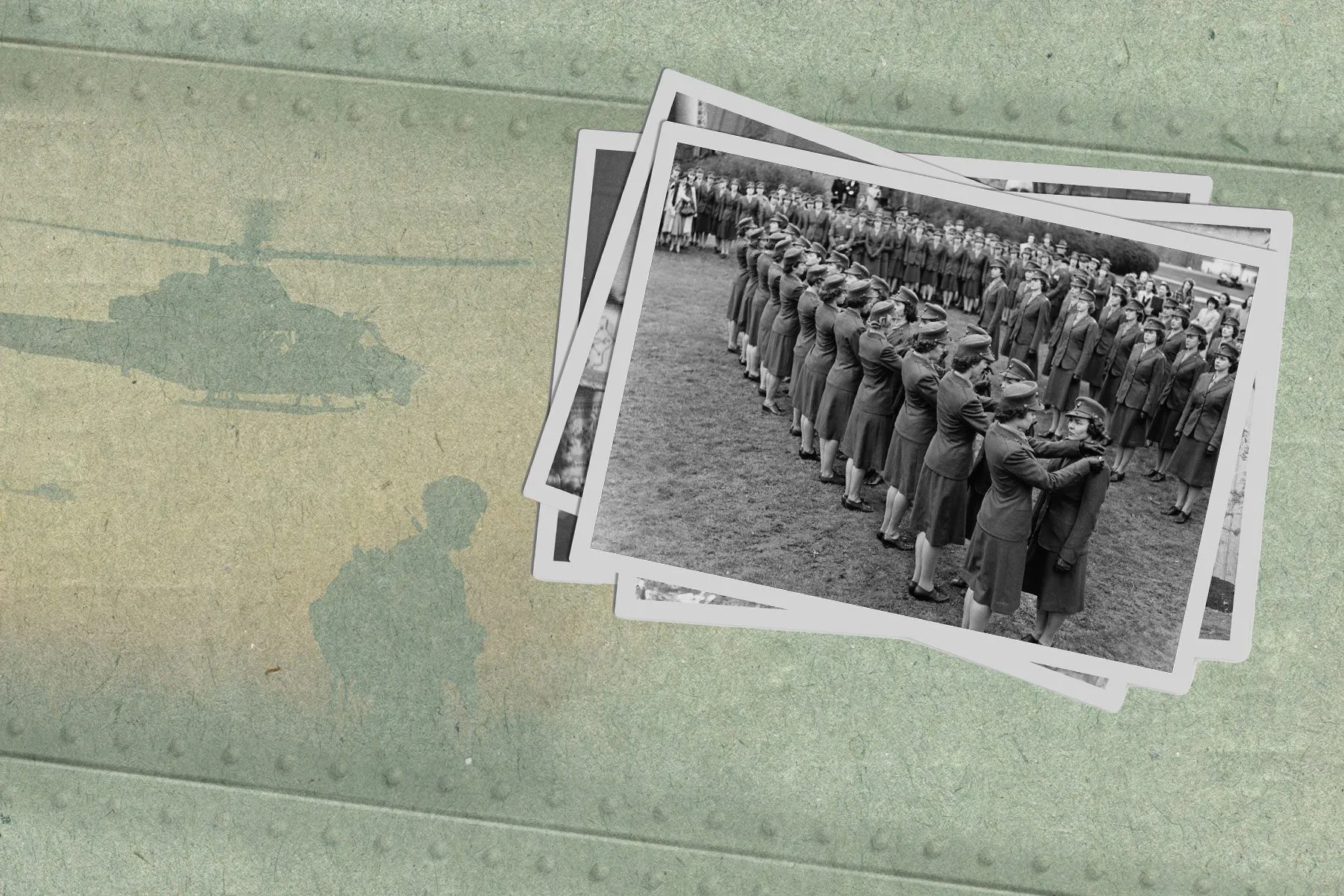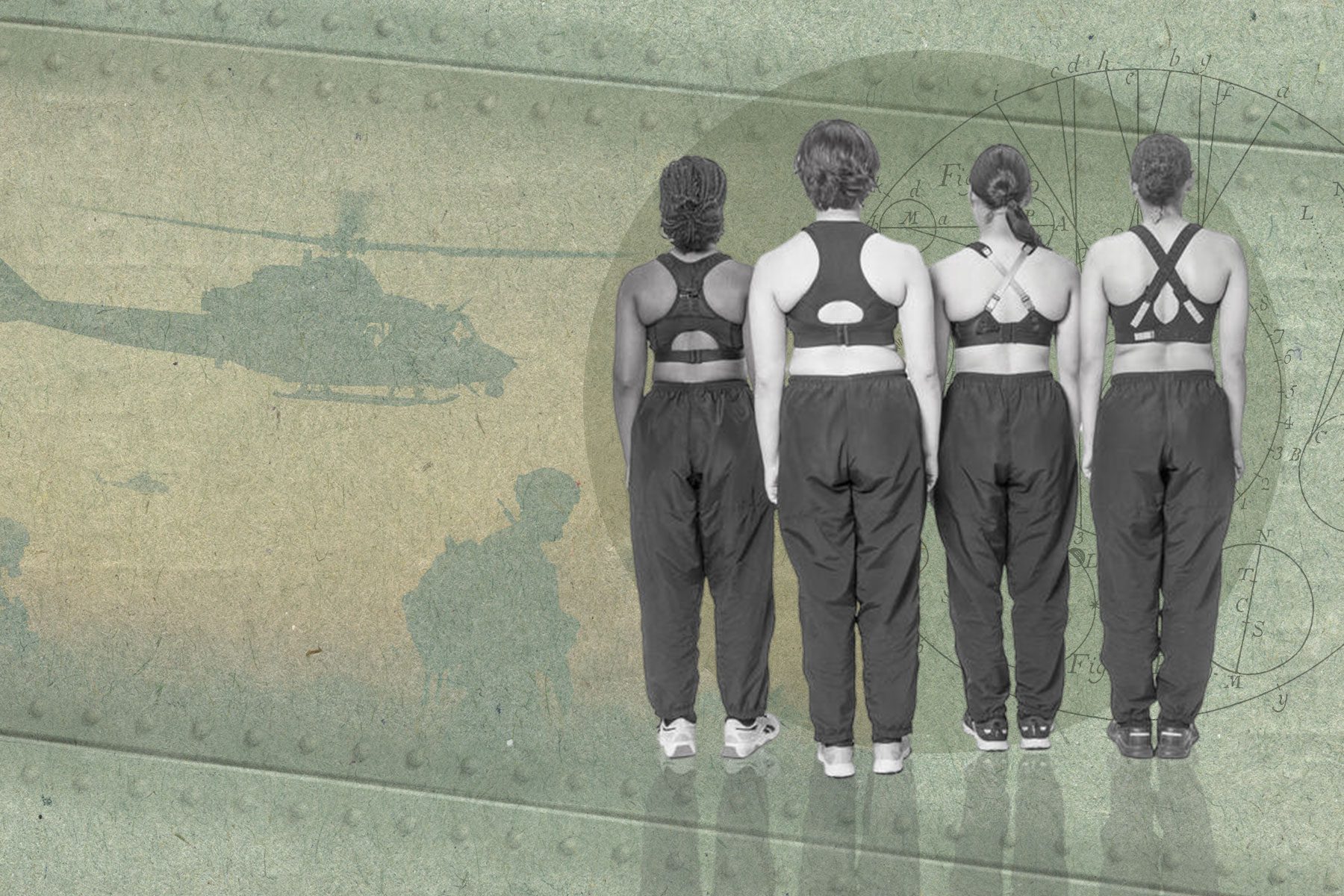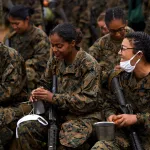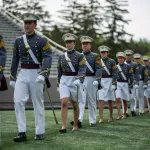Loretta Walsh was 20 years old when she joined the Navy, put on a modified men’s uniform and became the first woman to officially enlist in the United States Armed Forces. It was early 1917, and by the time the United States entered World War I that April, there would be 200 women in the military.
Walsh and the thousands of women who followed often served in uniforms designed for men or for body types not their own. At the time, women were only allowed to serve in noncombat roles, typically as clerical workers, telephone and radio operators, and translators. More than a century has passed, and with that has come change: Women were granted the right to serve as full members of the military with the 1948 passage of the Women’s Armed Services Integration Act. And nearly 70 years after that, in 2015, the military opened all combat roles to women. Women now account for the military’s largest-growing demographic, and military uniforms are slowly changing to meet the needs of the modern-day Armed Forces.
In the last decade, there has been a wave of changes to women service members’ uniforms — which many experts and historians agree reflects broader efforts to improve gender equity in the military. The Air Force launched a project to develop maternity flight suits after a study found nearly 400 pregnant airmen had to wear larger flight suits during pregnancy, a situation that creates safety issues. The Navy measured hundreds of sailors this year as part of an ongoing effort to create better uniforms tailored to women. Most recently, the DEVCOM Soldier Center — the Army’s research center — announced on Monday its first-ever designs for a tactical bra.
“The goal is not only accommodate soldiers that are doing field training exercises, but also those operating in combat environments where there could be potential exposure to different threats,” Ashley Cushon, a clothing designer and leader of design development at DEVCOM, said in a statement.
Service members can currently buy sports bras at commissaries and exchanges — stores on military bases. These items are not standard issue and must be paid for out-of-pocket, though service members are typically provided an allowance to buy non-standard-issue clothing that meet their personal preferences.
DEVCOM revealed four concept designs — the first bras optimized for women to use in combat. Soldiers will be able to customize the bras’ compression and support levels and, for those that prefer simplicity, there is an option with less fasteners and hardware. According to Cushon, the new designs include flame-resistant protection — from the thread, to the closure, to the seam.
“Females in general have become all too familiar with experiencing adverse effects related to the continued wear of an ill-fitting bra,” Cushon said. “Skin damage related to abrasion or pain in the breast, shoulders and back. … We are utilizing a combination of size, style and military-appropriate design elements for the individual soldier’s body type and activity level that can help to mitigate distractions related to ill-fit or discomfort that could compromise their focus — ultimately enhancing their readiness level while active.”
The Army Uniform Board — which addresses requirement changes and meets twice each year — is expected to review the concepts for approval sometime in the fall. If approved, they will be the first official uniform bras offered from the Army to soldiers.
Annette LaFleur, the team leader for the Design, Pattern and Prototype Team at DEVCOM, said that the designers listened to feedback from service member surveys and focus groups. The team collected information from more than 200 women soldiers stationed in Kansas, Georgia and Washington between December 2021 and March 2022. The researchers and designers also kept in mind that women soldiers are “ultimate athletes” who sometimes have to endure days on end in the cold, jungle or desert, LaFleur added.
“As with all uniform and individual protection items we develop and evaluate, our goal is for the soldier to not think about what they are wearing and be focused on their job,” LaFleur said in a statement.
Tanya Roth, a history teacher who wrote a book about the history of women in the military, said for so long military uniforms for women were about feminine fashion and the ideal American brand. It’s only been in the last decade that there’s been a significant shift towards function, Roth told The 19th.
“This marks a major change for the military,” Roth wrote last month in The Washington Post about the historical context behind women service members’ government-issued clothing. “Until now, female service members have purchased bras for themselves. Crucially, it also reflects a change in how military leaders perceive female soldiers.”
After repurposing men’s uniforms for women during the Great War, the U.S. military shifted to a more feminine uniform design as women continued to enter the military during World War II. Between 1943 and 1944, a slander campaign circulated that claimed these women were too manly or were attracted to other women. In response, the government issued women’s uniforms — that included a wool skirt, jacket, cap with a visor, russet oxfords with a one-and-a-half-inch heel and leather handbag with a shoulder strap — in an effort to send a message that America’s service women are “good, wholesome girls, the epitome of American femininity,” Roth said. Some service women were encouraged to go on diets or buy their own shapewear, including girdles, shoulder pads and push-up bras.
“The emphasis was always on: How did women look?” Roth said, noting they even had famous fashion designers, like Hattie Carnegie, designing the uniforms. “It was really more about making them look good — it sometimes feels to me like it was more like dressing a Barbie doll. Let’s make sure our women look good: They have the hat; they have the hair; they look like what we want a White American woman, particularly White middle class or upper class, to look like.”

After the war, uniform guidelines changed slightly. In 1946, women service members could buy and wear brown leather pumps while on duty. That year, nylon pantyhose were also issued for the first time to women in the Army — though they had to be diligent about making sure the seam that ran down the back of the leg remained straight.
At the onset of the Vietnam War in the 1950s, a group of women in the Women’s Army Corps stationed in Vietnam — many of them nurses — wrote to Washington, D.C., asking why they were required to wear uniforms that were for show but not functional in practice.
“In a tropical environment, their uniforms were getting sweat stains and showing dirt,” Roth said. “So they start raising that question: ‘Do you want us to look good or do you want us to do our work?’ What does it mean to have a practical, functional uniform? It’s still something that has taken the military another 50-plus years to address.”
Roth said she sees the beginning of a serious shift when it comes to military uniforms and gender equity. There seems to be more intentional inquiry being done into women’s physical needs, she said.
“When I look back at the ’70s, ’80s and ’90s, it sort of feels like we were just using stuff we already had,” Roth said. “But in the last decade we’ve seen more and more women move into different roles. Women who are mothers stepping up and talking about the physical changes their bodies go through and how that affects physical training after pregnancy or breastfeeding. … Now, I think important conversations are starting to happen.”
There are also efforts from Congress to push the military towards gender equity, particularly when it comes to requirements and costs. Last year, Congress voted to eliminate a “pink tax” on military uniforms after a government report found that women were disproportionately required to pay more out-of-pocket costs.
Democratic Sen. Maggie Hassan of New Hampshire, who co-sponsored the legislation, told The 19th that the military will be stronger if women service members are treated fairly.
“I am encouraged to see the Defense Department build on these efforts, and I will continue to work on bipartisan efforts to address gender disparities in the military and support all of our men and women in uniform.”
Suzanne Chod, a professor of political science at North Central College, said: “I think the first thing to note is that these initiatives were proposed by female legislators. This is one more example of why representation matters. Women’s perspectives, especially across different social identities, are critical to create more equitable policies.”
In 2018, the Army for the first time assembled an all-women board to provide feedback on the Army’s uniform design. The board unanimously voted to make pants, tailored to a woman’s body, the default standard issue. Skirts are still available for purchase, but they are no longer the default option.
Chod noted that measures related to women soldiers’ uniforms often enjoyed bipartisan support in both chambers of Congress, and that each seemingly incremental change would have a wider effect. “While these amendments may seem small in comparison to the systemic and institutional inequities in the military that need to be addressed, they make a real difference in female service members’ day-to-day lives. From hair, to better fitting uniforms, to making uniforms and other necessary apparel more affordable, these changes in policy allow female service members to feel more like themselves, to be themselves, and to do their jobs better.”
Kara Dixon Vuic, who studies gender and the U.S. military at Texas Christian University, said the changes are long overdue.
“Broadly, all of this is indicative of the military’s paying attention to gender-specific needs in an overall effort to more fully integrate women,” Vuic said. “It’s almost like death by 1,000 paper cuts for women in the military: You’re paying more for your uniform, you have to go buy the things you need off-post, you can’t wear your hair the way you need.”
For so many years, some uniform requirements and guidelines were perpetuated because “that’s just the way it is,” but Vuic said she hopes leadership continues to further change by considering the growing number of women’s perspectives — for the benefit of the entire Armed Forces.
“All of these things have a psychological impact and are just subtle ways of saying you don’t belong or that you’re an addition to this established routine — which suggests that you’re not fully part of it,” Vuic said. “When I first saw the news about the tactical bra, my first response was: They don’t issue bras? I can’t believe this is 2022 and we’re just now officially issuing these things.”






